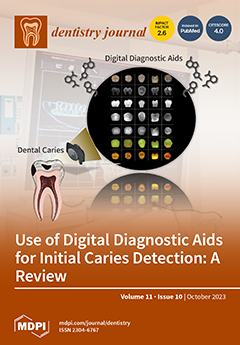Background: Macro-geometry and surgical implant site preparation are two of the main factors influencing implant stability and potentially determining loading protocol. The purpose of this study was to assess the initial stability of various implant macro-designs using both magnetodynamic and traditional osteotomy techniques in low-density bone. The parameters examined included peak insertion torque (PIT), implant stability quotient (ISQ), and peak removal torque (PRT). Methods: Four groups of 34 implants each were identified in accordance with the surgery and implant shape: T5 group (
Five implant and osteotomy using drills); M5 group (
Five implant and magnetodynamic osteotomy using Magnetic Mallet); TT group (
TiSmart implant and osteotomy with drills); and MT group (
TiSmart implant and magnetodynamic osteotomy). Every implant was placed into a low-density bone animal model and scanned using CBCT. The PIT and PRT were digitally measured in Newton-centimeters (Ncm) using a torque gauge device. The ISQ was analyzed by conducting resonance frequency analysis. Results: The PIT values were 25.04 ± 4.4 Ncm for T5, 30.62 ± 3.81 Ncm for M5, 30 ± 3.74 Ncm for TT, and 32.05 ± 3.55 Ncm for MT. The average ISQ values were 68.11 ± 3.86 for T5, 71.41 ± 3.69 for M5, 70.88 ± 3.08 for TT, and 73 ± 3.5 for MT. The PRT values were 16.47 ± 4.56 Ncm for T5, 26.02 ± 4.03 Ncm for M5, 23.91 ± 3.28 Ncm for TT, and 26.93 ± 3.96 Ncm for MT. Based on our data analysis using a t-test with α = 0.05, significant differences in PIT were observed between TT and T5 (
p < 0.0001), M5 and T5 (
p < 0.0001), and MT and TT (
p = 0.02). Significant differences in the ISQ were found between TT and T5 (
p = 0.001), M5 and T5 (
p < 0.001), and MT and TT (
p = 0.01). The PRT also exhibited significant differences between TT and T5, M5 and T5, and MT and TT (
p < 0.0001). Conclusion: Our data showed favorable primary implant stability (PS) values for both implant macro-geometries. Furthermore, the magnetodynamic preparation technique appears to be more effective in achieving higher PS values in low-density bone.
Full article






